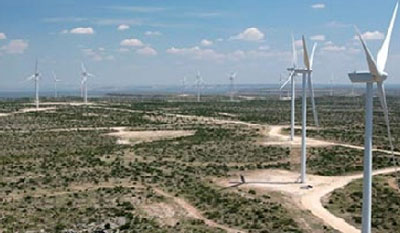The results are in for wind industry growth in 2014, with the US and China continuing their leadership positions.
Developers in the both countries (and Germany) rushed to get projects in the ground before incentives declined or expired -leading to 4.7 gigawatts (GW) added in the US and an impressive 20.7 GW in China, according to Bloomberg New Energy Finance (BNEF).
In the US, projects had to be started by the end of 2014 – which means a good year ahead – and in China, the feed-in tariff will soon be cut.
Last year, capacity grew 38% in China, where a total of 96 GW of wind is now installed, says BNEF. After leading the world with 16 GW installed in 2013, China’s government raised the target to 200 GW by 2020.
Even though China leads on capacity, the US pumps out more wind energy.
The other top countries for wind additions are Germany (3.2 GW), Brazil (2.7 GW) and India (2.3 GW).
947 MW Alta Wind Energy Center in California, the biggest wind farm in the world so far:

Jobs From Offshore Wind
Just as the US is about to get its first – if tiny – offshore wind farm and Republicans get ready to push for extensive offshore oil drilling in the Atlantic, another report shows the advantages of offshore wind.
Offshore wind would create double the jobs and double the energy as offshore drilling in the Atlantic Ocean, reports Oceana, while drilling would actually threaten the 1.4 million jobs in fishing, tourism and recreation. And the threats begin with oil exploration – where seismic airguns blast the ocean floor from Delaware to Florida, harming millions of fish, dolphins and whales.
"Unlike offshore drilling, offshore wind provides power directly to coastal communities where we need energy the most, without the risk of oil spills or carbon pollution," says Andrew Menaquale, author of the report and energy analyst at Oceana. "It’s time for the US to use the lessons learned from more than 20 years of offshore wind development internationally and apply them to generating clean, renewable energy off our coasts."
Findings include:
- In 13 years, offshore wind could generate more energy than all economically recoverable offshore oil and gas resources.
- Gradual offshore wind development for the next 20 years, would supply electricity to over 115 million households.
- Extracting all recoverable oil would meet 5 months of demand, and 10 months of gas demand at current consumption rates.
- The Atlantic Ocean contains less than 4% of US oil reserves and less than 3% of gas reserves.
A previous study shows offshore wind could power the entire Atlantic coast, while creating 300,000 jobs, and would also protect the coast from devastating hurricanes.
Read Oceana’s report, Offshore Energy By the Numbers:
